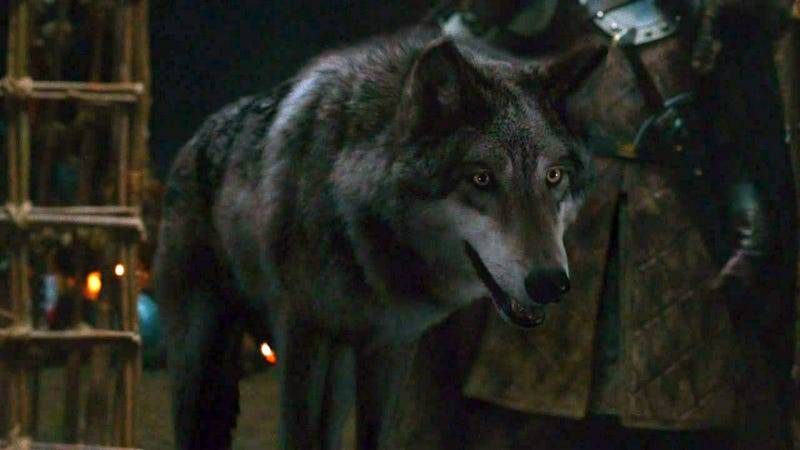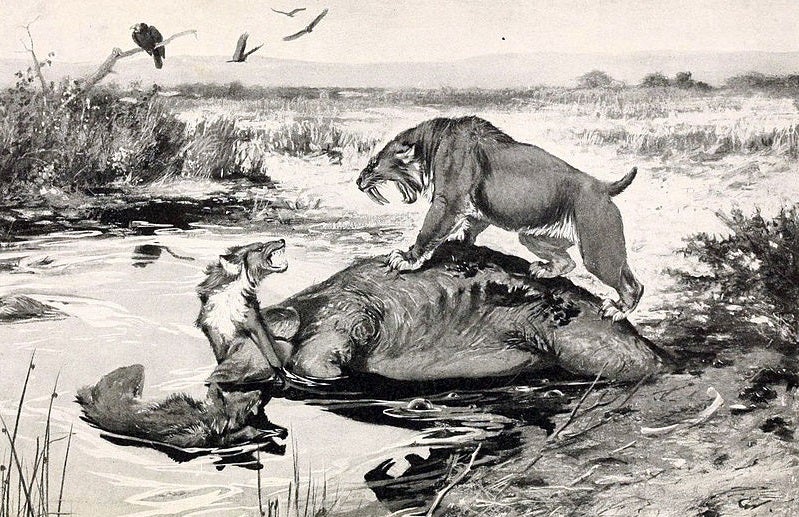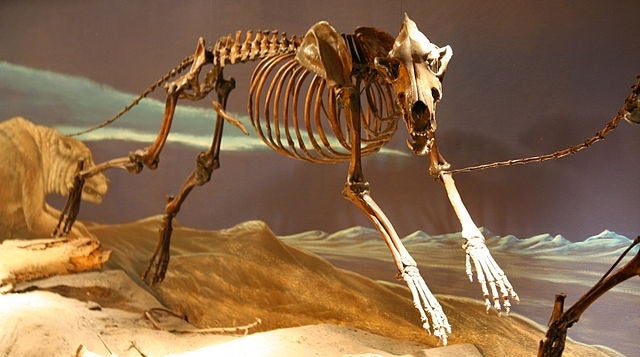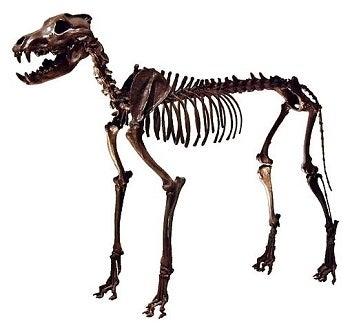Explainer
9/09/15

Game of Thrones
has put direwolves back on the map—but they really existed. If you’d
been walking through a glade 15,000 years ago, and noticed a really big
wolf coming out of the forest, followed by more really big wolves, you’d
need to run fast. Because dire wolves were real.
Let’s say
you’re strolling through a glade 15,000 years ago. A wolf comes out of
the forest. “Oh, that’s a big one,” you think. More wolves come out. You
slowly realize—they’re all big ones. Those are dire wolves. Get ready to run.
The Discovery of Dire Wolves
The dire wolf was first described by Joseph Leidy,
a physician and scientist who had an admirable flair for the dramatic.
He started his career with much less dramatic animals. In the 1840s, he
used fine tools and microscopes to dissect and examine mollusks. His
talents for physiological description and microscopy diverged and
flourished.

He made
contributions to science as varied as proving that North America had an
ancient species of horse which died out before modern horses were
introduced, and gently suggesting that, if a pork chop had larva inside
it, it was probably a good idea to cook it more thoroughly.
By 1854 he was sufficiently eminent to be sent fossils, including the odd canine fossil from a young man called Frances Lincke.
Leidy analyzed the fossil, determined that it was definitely not from a
species of canine currently scampering around the Americas, and called
it Canis dirus.

How Would a Dire Wolf Have Brought You Down?
Dire wolves are sometimes listed as the largest canid species ever to have existed,
but they weren’t what we think of as megafauna. The largest of them
were around 175 pounds, and they were only about 30 pounds heavier, on
average, than the wolves currently alive today. In terms of height, they
weren’t as tall as modern wolves. The weight they had went into a heavy
build. They were broad-chested, not long-legged.

When
scientists study fossils of dire wolves, they’re looking at a long
history spread over a large area. The species emerged 300,000 years ago
in North America, and spread over multiple continents. It even had
variations on form—the Eastern dire wolves were a bit bigger than
Western dire wolves. Despite the expanse of time, it is possible to make a few conclusions.
Physiologically,
dire wolves were not a varied bunch, even between the sexes. Slightly
larger teeth on the males are the only real sexual variation that
anyone’s found. They hunted in packs, bringing down horses and bison.
Good hunts might have brought down a giant ground sloth. During lean
times they would have turned to scavenging carcasses—many dire wolves
have worn or broken teeth from chewing bones—and eaten what smaller
animals they could catch. That’s not really different from modern
wolves.
There is
one difference that might make you look at a dire wolf with more dread
than a regular wolf. A lot of studies have been done comparing
the various strengths of modern wolf teeth, hyena teeth, dire wolf
teeth, and saber-toothed-cat teeth. Dire wolves didn’t have the toughest
teeth in the business, and they weren’t accustomed to crunching down on
bone. They had something else.

Put your
hand on your chin and trace back along your jaw until you get to the
“corner.” Slide your fingers up until they feel the slight ridge on your
skull just over your jaw. That’s the zygomatic arch. Dire wolves had an
arch that’s far more prominent than modern wolves. Next find the band
of muscle on either side of your skull that gets gets stressed whenever
you chew too much. That’s the temporal muscle. Dire wolves also had a
very pronounced temporal muscle. They weren’t biting down on bones (at
least not when they could help it), but they were using extra bite
strength for something.
According to one study, “It
is inferred that the dire wolf exhibited feeding behavior that
approached that of the living gray wolf, but may have differed in
killing technique, where it held longer to its struggling prey.”
Isn’t that a pleasant thought.
The Dawn Before the Dark
A strange thing happens in dire wolf fossils found between 15,000 and 12,000 years ago.
Dire wolves get healthier, especially in terms of dental equipment.
Their teeth are less worn, and fewer teeth are broken. This indicated
that the wolves were scavenging less on bony carcasses and eating more
succulent prey. After hundreds of thousands of years of taking whatever
larger predators had left behind, or fighting them for their own kills,
dire wolves are feeding themselves exclusively on meat and leaving aside
tougher stuff. Things seem to be looking up.

It was a
false dawn. In another two thousand years, the dire wolf would be
extinct. The dire wolves were eating more because the huge predators
were dying off, leaving them with no competition for the huge,
slow-moving megafauna. Soon the megafauna were also dying. After the big
ground animals disappeared, the smaller, more fleet-footed animals were
all that were left. They were being hunted by what we think of as modern wolves—which
shared the world with dire wolves for tens of thousands of years. The
stocky bodies of the dire wolves just weren’t able to survive, while the
smaller, thinner, faster modern wolves did.
So today, we live in a world with the animals that outran the dire wolves.
Top Image: Game of Thrones. Second Image: Robert Bruce Horsfall Third Image: Lora 313 Skeleton Alone Image: Momotarou. Wolf/Dire Wolf Comparison Image: John Merriam, John Campbell
source


This is informative.
ReplyDelete